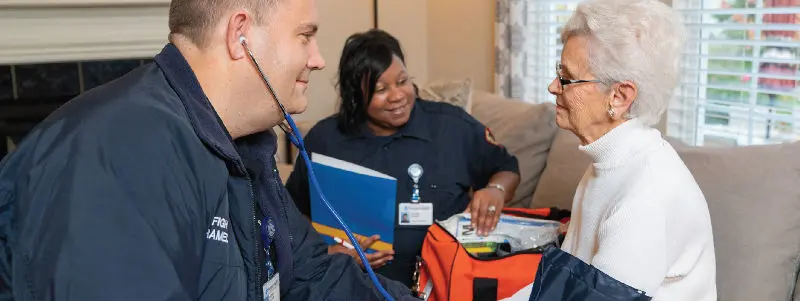Effectively managing community health within fire departments and EMS agencies is crucial for immediate response and long-term wellness. Their frontline involvement allows them to engage with individuals during health crises, giving them a unique opportunity to influence community health outcomes proactively. By integrating health management strategies into their operations, Fire and EMS can address emergencies, prevent future health issues, and improve overall quality of life.
The CDC has also reported that fire and EMS outreach programs focusing on fall prevention and chronic disease management have reduced emergency calls for falls by 30% in communities that actively participate in these programs.
As of 2023, Mobile Integrated Healthcare (MIH) and Community Paramedicine programs have reduced non-emergency 911 calls by 50% and decreased ER visits by up to 40% in participating regions. These statistics show the impact that proactive, community-based health interventions can have. They demonstrate that Fire and EMS are crucial for emergency response and critical players in advancing public health and reducing healthcare costs.
Why Partner with EMS and Fire Departments to manage Community Health?
Partnering with fire and EMS departments to manage community health offers many advantages. These departments are already trusted within their communities and have an established presence in emergency response. Their involvement allows quicker, more effective interventions, especially in underserved or high-risk areas.
Fire and EMS personnel are often the first point of contact in medical emergencies, making them well-positioned to provide preventive care, conduct wellness checks, and manage chronic conditions in the community. By collaborating with them, communities can create a more proactive, integrated approach to healthcare, reducing the strain on emergency rooms and improving overall health outcomes.
Steps to Start a Community Outreach Program
EMS and fire departments increasingly recognize the potential of Mobile Integrated Health (MIH) programs to improve community health and reduce unnecessary emergency room visits. By leveraging their existing resources and expertise, fire departments can implement MIH programs that provide proactive care and address community needs. Here’s a guide to help you through the deployment process.
- Conduct a Thorough Needs Assessment
- Identify target populations: Determine which segments of your community are most likely to benefit from MIH services, such as individuals with chronic conditions, the elderly, or those with substance abuse or mental health issues.
- Assess current healthcare needs: Analyze data on emergency room visits, ambulance calls, and hospital readmissions to identify common health problems and gaps in care.
- Evaluate existing resources: Assess the availability of primary care providers, social services, and other community-based resources that could support an MIH program.
- Build Strong Partnerships
- Collaborate with healthcare providers: Establish partnerships with primary care physicians, hospitals, and specialty clinics to coordinate care and ensure seamless transitions between MIH services and traditional healthcare settings.
- Engage with community organizations: Work with social service agencies, mental health organizations, and community centers to address the social determinants of health and provide comprehensive care.
- Involve fire department staff: Ensure buy-in from fire department personnel by involving them in the planning and implementation.
- Leverage Fire Department Resources
- Utilize existing vehicles and equipment: Consider using fire department vehicles, such as ambulances or fire trucks, for MIH services to minimize costs and leverage existing infrastructure.
- Train fire department personnel: Provide specialized training to fire department personnel, such as EMTs or paramedics, to enable them to deliver MIH services effectively.
- Leverage existing networks: Utilize the fire department’s existing network of community contacts to reach out to vulnerable populations and promote MIH services.
- Develop Program Protocols and Guidelines
- Define the scope of services: Determine the specific services that your MIH program will offer, such as chronic disease management, medication management, and social needs assessments.
- Establish protocols: Develop clear protocols for identifying eligible patients, assessing their needs, and providing appropriate interventions.
- Ensure quality assurance: Implement quality assurance measures to monitor the program’s effectiveness and make necessary adjustments.
- Secure Funding and Resources
- Explore funding opportunities: Identify potential funding sources, such as grants, government programs, and private donations, to support the MIH program.
- Maximize efficiency: Implement cost-saving measures, such as utilizing existing resources and negotiating favorable contracts with healthcare providers.
- Demonstrate value: Clearly articulate the benefits of the MIH program to potential funders and stakeholders, highlighting its potential to improve health outcomes and reduce healthcare costs.
By following these steps, fire departments can successfully implement MIH programs that provide valuable healthcare services to their communities and improve patient outcomes. Creating a smart, data-driven, measurable plan will optimize resources and generate meaningful results, highlighting their positive impact.
How EPR’s Mobile Integrated Health Supports Community Medical Care and Improves Response Effectiveness
EPR’s Mobile Integrated Health (MIH) module is specifically designed to enhance the ability of paramedics and community paramedics to manage chronic diseases and provide home-based care, preventing hospital admissions and readmissions. With its robust client management features, the MIH module allows users to easily view and filter clients by visit dates, medical conditions, or specific health needs such as congestive heart failure, diabetes, chronic kidney disease, or overdose cases. The module also includes comprehensive client records containing personal details, visit histories, medications, and ongoing health activities, which are crucial for effective follow-up care.
In addition, the MIH module facilitates seamless documentation and attachment management, making it easier to track and store critical patient information. It also includes custom filters that help prioritize care based on urgency and patient needs, optimizing resource allocation. By incorporating detailed contact management, the module ensures coordinated care among key contacts, such as family members, caregivers, and healthcare providers.
Please contact us for more information about activating this module and enhancing your department’s community medical care capabilities.


